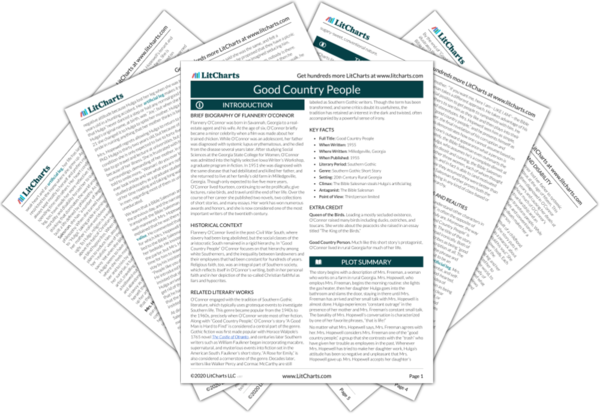Class, Identity, and Superiority
In “Good Country People”, Mrs. Hopewell sees the people of her world as falling into a clear hierarchy. At the bottom is a group of people she calls “trash,” whom she describes as poor, uncultured, and essentially criminal. Next is a group she identifies as “good country people.” These people are poorer than landowners like Mrs. Hopewell and her daughter Hulga, as well as less educated. Mrs. Hopewell champions these people as “the salt…
read analysis of Class, Identity, and SuperiorityAppearances and Realities
The way characters understand other characters in “Good Country People” is often the opposite of how these characters truly are. Moreover, the way characters present themselves in “Good Country People” is often the very opposite of how they are. The title of the story, “Good Country People,” is meant to be read ironically. Both of the characters whom Mrs. Hopewell describes as being “good country people” turn out not to fit that description at all…
read analysis of Appearances and RealitiesAuthentic Faith and Vulnerability
“Good Country People” offers few glimpses of true, authentic faith. More often, the characters demonstrate false claims of devotion. Mrs. Hopewell lies about keeping a Bible at her bedside to give the impression that she is religious. The Bible Salesman, who claims to be devout, turns out to be hiding alcohol, condoms, and pornography inside a hollowed-out Bible. And the protagonist, Hulga, is condescending toward any religious sentiment.
There is one moment in the…
read analysis of Authentic Faith and Vulnerability
Disease and Disability
Flannery O’Connor lost her father to systemic lupus erythematosus at the age of fifteen. This same disease was then diagnosed in O’Connor herself, debilitating her for many years and causing her death at age 39. Disease is present throughout much of O’Connor’s work, and she uses it to show how true hardship and an awareness of one’s own mortality can transform people. While Mrs. Hopewell lives in a world of clichés and conventional morality, Hulga…
read analysis of Disease and DisabilityHypocrisy
Every character in “Good Country People” believes he or she has the moral high ground, but none of them leads the ethical life they claim to. In different ways, they are all hypocrites, claiming to honor and to have higher moral standards than they actually do.
Mrs. Hopewell, for example, speaks with authority about the difference between “good country people” and “trash.” Throughout the story, she projects an air of moral superiority, but it’s…
read analysis of Hypocrisy











